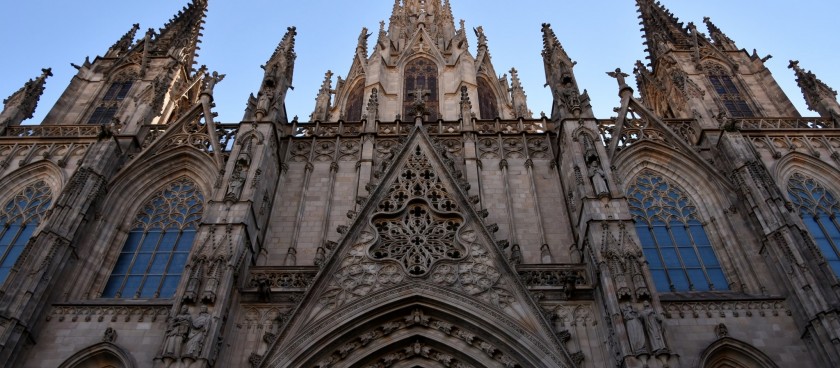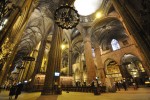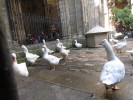- #ES07
- Pla de la Seu, s/n, 08002 Barcelona, Spain
- +34933151554
- info@catedralbcn.org
- catedralbcn.org
- Working hours*:
Opening hours for worship and prayer:
8:30-12:30 and 5:45-7:30
Cultural and tourist visit hours:
12:30-7:45 - * - opening and closing times as well as entrance prices, are subject to alterations without notice. Visitors are advised to check before visiting.
- 41.3839630, 2.1761980 Copy to clipboard Copy
-
#Churches , #Architecture
History
The city of Barcelona must have received the light of Christian faith very early on. The martyrdoms of Saint Eulalia and Saint Cucuphas during the Diocletianic Persecution bear witness to the existence of Christians in Barcelona at least by the late 3rd and early 4th centuries.
Unfortunately, we have no historically proven records of the ecclesiastical organization of our dioceses until 343, when Bishop Praetextatus of Barcelona and another five bishops of Hispania attended the Council of Sardica to ratify the provisions set forth in the Ecumenical Council of Nicea (325) as to the divinity of Jesus Christ.
Certain solidly grounded conjectures lead us to believe that Barcelona already had an Episcopal temple or Cathedral at that time, which would be used soon thereafter for pastoral ministry by other key bishops of our diocese: Saint Pacian (390), Lampius (400), Nundinarius (461), Nebridius (540), Ugne (599), Severus (633), Quiricus (656), Idalici (688), Laülf (693), Frodoí (890), etc. In the year 599 our Cathedral appears in a document dedicating it to the Holy Cross (Second Council of Barcelona).
Recent excavations of the substrata of the Carrer dels Comtes of Barcelona (which currently runs along the Eastern wall of the Cathedral) brought to light a building comprising three naves separated by two series of white marble columns. This undoubtedly identifies with the paleo-Christian basilica constructed in the 4th century and ennobled by subsequent bishops over seven centuries despite the difficulties caused by the Arian fight.
That early basilica solemnly housed the relics of Saint Eulalia in one of its chapels, hidden to avoid profanation by the Arab invaders of our peninsula (711). In 877 they were miraculously discovered at the temple of Santa María de les Arenes (or Santa María del Mar).
The primitive Cathedral, profoundly affected when the Arab chieftain Almanzor burned and destroyed the city, remained standing until 1046, when the Count of Barcelona, Ramon Berenguer the Old and his wife Almodis, together with Bishop Guislabert, commenced construction of another Cathedral, called the Romanesque Cathedral. That second Cathedral was consecrated on 18 November 1058 by the Archbishop Wilfred of Narbonne.
The Gothic Cathedral we have today was built on the foundations of the primitive paleo-Christian basilica and the subsequent Romanesque Cathedral. Construction commenced on 1 May 1298 during the mandate of Bishop Bernardo Pelegrí and the reign of King James II of Aragon, the Just, and was virtually completed by the mid-15th century, under the mandate of Bishop Francisco Clemente Sapera and the rule of King Alfonso V of Aragon.
Three distinct periods can be defined within the 150 years of construction: in the first, the building was planned and the apse and radial chapels were built, as were the presbytery - with its altar and crypt- and the pseudo transept; afterward, the three naves, with their respective lateral chapels, were extended back to the choir; finally, construction of the basilica continued to the façade, which was later closed with a simple wall (1417). The Cloister was finished in 1448.
At the end of the 19th century, the Barcelona industrialist Manuel Girona Agrafel offered to undertake the work on the façade and on the two side towers, in keeping with the plans drawn up by the architect Josep O. Mestres and inspired by the initial 15th-century project. Mr Girona's children finalized their father's work in 1913 on completion of the cimborio.
Architecture
The Cathedral of Barcelona is comprised of three naves, but just a single apse and ambulatory. The naves have five sections: that closest to the façade is the longest in order to accommodate the dimensions of the cimborio, which is adjacent to the main entrance.
The typical structure used in Catalan Gothic constructions, arranged to permit use of the spaces within the buttresses, allowed rows of secondary chapels to be opened up in the Cathedral. There are two chapels in each section of the naves, encircling the entire basilica.
Two large bell towers are located at the ends of the section nearest to the presbytery, with no side chapels. One of the towers is over the door of Saint lvo and the other is over the interior entryway to the Cloister. On the basilica's terraces, these towers are octagonal with a prismatic body used for the stairways, which are built into the towers (1386-1393 and 16th century).
Large windows open up onto the radial chapels of the ambulatory, illuminating the presbytery. In the lateral naves, a tall, windowed gallery runs above the chapels on the outer wall of the basilica. A small triforium runs around the central nave and the presbytery near the dome.
Traditions:
The geese
There is a pond with a fountain in the Cloister of the Cathedral. It is home to 13 white geese representing, according to tradition, the age of Saint Eulalia when she was martyred.
Blessing of the district
On 3 May at 9:00 am the municipal district of Barcelona is blessed from the rooftops of the Cathedral, on the occasion of the Day of the Holy Cross, for which the Cathedral is named. This act is open to everyone who wants to participate.
Corpus Christi
For the celebration of the Day of the Body and Blood of Christ, a Mass is held in the Plaza of the See, presided over by the archbishop of Barcelona and is followed by a procession of the Holy Sacrament through the surrounding streets. This celebration includes the participation of the bestiari (traditional Catalan figures brought out for holidays) and the castellers (human towers) and other dances traditional to the city.
The dancing egg (l'ou com balla)
Each year for the celebration of Corpus Christi, the traditional dancing egg comes to the Cloister of the Cathedral.
This custom consists of making an egg dance on the water of the Cloister fountain, which is decorated with flowers and red cherries.
The Cathedral of Barcelona was the first to present the dancing egg in Barcelona, going back at least to 1636.
Saint Lucia
On her feast day, 13 December, devotees of this martyr and protector of sight visit the Romanesque chapel dedicated to the Saint to adore her relics.
Saint Lucia Fair
The Saint Lucia Fair runs from the beginning of December to the 23rd of the month, with the sale of nativity figures and Christmas decorations. It is held on the Avenida de la Catedral.
Saint Rita
On 22 May, feast day of Saint Rita of Casia (who has a chapel dedicated to her in the Cloister of the Cathedral), roses are blessed after the 11:00am Mass.



